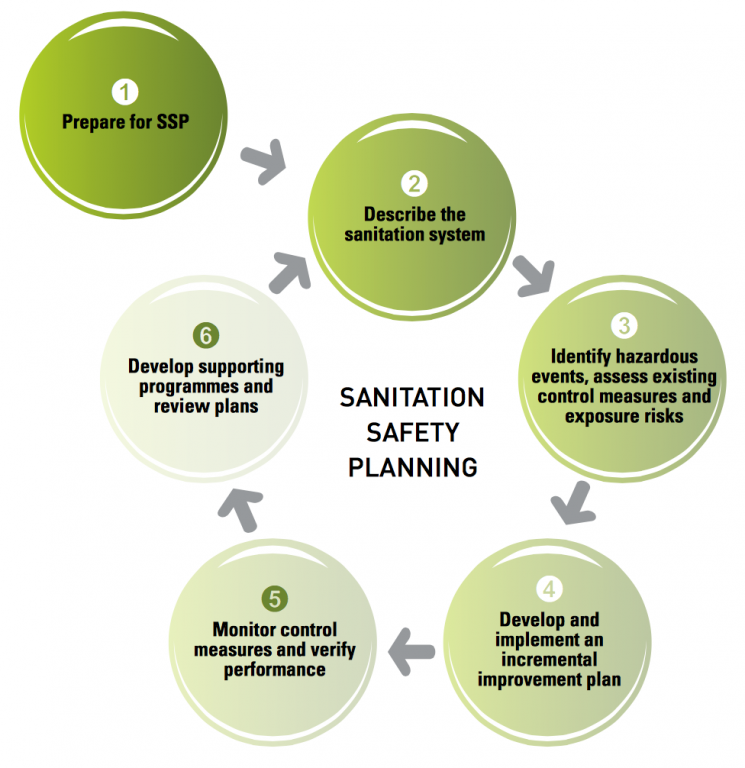Executive Summary
Sanitation Safety Planning (SSP) is a risk based management tool for sanitation systems that assists in the implementation of the 2006 WHO Guidelines for Safe Use of Wastewater, Excreta and Greywater in Agriculture and Aquaculture.
Introduction
The underlying purpose of sanitation interventions is to protect public health. Management and investments in improvements on sanitation systems should be made based on adequate understanding of the actual health risks posed by the systems and how these risks might best be controlled.
Sanitation Safety Planning (SSP) is a risk based management tool for sanitation systems. The SSP manual provides practical step-by-step guidance to assist in the implementation of the 2006 WHO Guidelines for Safe Use of Wastewater, Excreta and Greywater in Agriculture and Aquaculture (Volume II, III, IV). However, the approach and tools in the manual can be applied to all sanitary systems to ensure the system is managed to meet health objectives.
The SSP manual is targeted at a variety of users at different levels:
- local authorities (e.g. as a tool for planning investment in sanitation especially in low resource settings);
- wastewater utility managers (e.g. to assist in managing effluent quality and safeguarding public and occupational health from source to end use or disposal);
- sanitation enterprises and farmers (e.g. to complement quality assurance procedures for safety of end products, workers, local communities, and consumers or users of the product);
- community based organizations, farmers associations and NGOs (e.g. to support community based water and sanitation programs in safe use of human wastes).
In addition to its site specific use related to a particular SSP process, SSP is also useful for those working at a national level, including:
- health authorities and regulators (e.g. as a tool to introduce risk based approaches in the sanitation sector, and verify their effectiveness);
- those guiding the development of policies and programmes to improve the sanitation management.
The SSP manual assists users to:
- systematically identify and manage health risk along the sanitation chain;
- guide investment based on actual risks, to promote health benefits and minimize adverse health impacts;
- provide assurance to authorities and the public on the safety of sanitation-related products and services.
Sanitation Safety Planning Modules
This manual presents the SSP process in six modules.

Sanitation Safety Planning modules. Source: WHO (2015)
Module 1: Prepare for Sanitation Safety Planning
Preparing for the SSP process requires clarity on the priority area, the specific public health objectives of the SSP and the components in the sanitation chain that need to be included to meet the objectives. Additionally a lead organization and team need to be identified. These should represent the various steps of the sanitation system.
Module 2: Describe the Sanitation System
The main objective of Module 2 is to generate a complete description of the sanitation system within the boundary identified in Module 1. A thorough understanding of all parts the sanitation system and its performance requirements supports the subsequent risk assessment process.
Module 3: Identify Hazardous Events, Assess Existing Control Measures and Exposure Risks
An underlying purpose of all sanitation systems is to protect public health. Module 3 ensures that subsequent efforts and investments in system monitoring and improvements respond to highest health risks first.
Module 4: Develop and Implement an Incremental Improvement Plan
In Module 3, the SSP team identified the highest priority risks. Module 4 allows flexibility in selecting new control measures or other improvements that address these risks at the most effective places in the system. This process helps to ensure that funding and effort targets the highest risks with greatest urgency.
Module 5: Monitoring Control Measures and Verify Performance
Sanitation systems are dynamic. Even the most well designed systems can under-perform and result in unacceptable public health risk and loss of confidence in the service or products. Module 5 develops a monitoring plan that regularly checks that the system is operating as intended and defines what to do if it is not. Operational and verification monitoring provide assurances to the operators, the public and the authorities of adequate system performance.
Module 6: Develop Supporting Programmes and Review Plans
Module 6 supports the development of people’s skills and knowledge, and an organization’s ability and capacity to meet SSP commitments. Existing programmes (e.g. training) may be reconsidered in light of the extent to which they support the SSP objectives.
Sanitation Safety Planning. Manual for Safe Use and Disposal of Wastewater, Greywater and Excreta
This manual provides practical step-by-step guidance to assist in the implementation of the 2006 WHO Guidelines for Safe Use of Wastewater, Excreta and Greywater in Agriculture and Aquaculture
WHO (2016): Sanitation Safety Planning. Manual for Safe Use and Disposal of Wastewater, Greywater and Excreta. Geneva (Switzerland): World Health Organisation (WHO). URL [Accessed: 28.03.2019] PDFSanitation Safety Planning. Manual for Safe Use and Disposal of Wastewater, Greywater and Excreta
This manual provides practical step-by-step guidance to assist in the implementation of the 2006 WHO Guidelines for Safe Use of Wastewater, Excreta and Greywater in Agriculture and Aquaculture
WHO (2016): Sanitation Safety Planning. Manual for Safe Use and Disposal of Wastewater, Greywater and Excreta. Geneva (Switzerland): World Health Organisation (WHO). URL [Accessed: 28.03.2019] PDF
